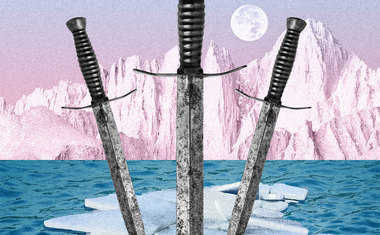
Introduction to Iconology of the Early Tarot
The origins of Tarot cards
"The first function of history is to open our minds to the infinite wealth of possible worlds and to help us to understand that our own view, whatever it may be, is precarious, limited, and open to sudden and radical change." (Russell 1984 p. 12).
The primary purpose of this series of essays is to provide evidence that the Tarot originated in northern Italy in the 15th century. This was the intellectual, cultural, and religious milieu within which the Tarot was invented. The fundamental evidence offered here is the images themselves. No earlier period and no other geographic venue can claim the wealth of visual evidence that is presented here.
We do not know what the first Tarot deck looked like. Given that simple fact, there is no rationale for giving special weight to one or another of the surviving hand-painted and woodblock printed decks. So for present purposes we will consider all of the oldest decks that are available through the efforts of Stuart Kaplan (1978, 1986). We will look for contemporary imagery that resembles all or most of the surviving Tarot cards.
We do not know the original ordering of the Tarot cards. Dummett (1980) argues that the surviving decks and contemporary documents fall into three major types. For present purposes we will follow the Type B ordering. This ordering, which differs from the familiar Tarot de Marseille numbering, appears to have the best documentary credentials for being the oldest arrangement. As we examine the individual cards, we will find that the Type B ordering is also recommended by the iconology of the Tarot symbols themselves.
The primary source of the imagery appears to be the religious art that surrounded the card-player in every church, public building, and piazza. Much of religious art was deliberately allegorical and symbolic providing visual reinforcement for the Church's moral message. Davidson (1989) shows this visual education carried over into costumes and characters in the 15th century morality plays. There can be little doubt that the card-players were inundated with this imagery and its significance.
In addition to the general religious and secular art of the period, there appear to be four parallel artistic traditions that were drawn upon as sources for the Tarot imagery. The relationship between the early Tarot and illustrations of Dante's Divine Comedy is considered in a separate article.
Moakley (1966) suggested a second source in the epic poem "I Trionfi" by Petrarch. We will deal with the details of Moakley's hypothesis in a separate article but the artistic tradition will be considered here. The triumphal tradition actually begins with Prudentius' "Psychomachia" in the 5th century which was preserved in a number of illustrated manuscript from the 9th to the 13th centuries (Katzenellenbogen 1939). Sticca (1990) points out that there were a number of other works based on the triumphal theme that preceded Petrarch. But Petrarch's popular poem was the immediate stimulus for the artistic tradition in the 14th and 15th centuries (Dodge 1990, Charney 1990, Eisenbichler and Iannucci 1990, Paoletti and Radke 1997).
The basic outline of Petrarch's poem portrays the moral and spiritual development of a person as a series of trumphal chariots carried past the reader. Each chariot bears an allegorical figure such as Love, Time, or Eternity together with an entourage of historic and mythic figures. The poetic imagery inspired many artists to illustrate the allegories. There are literally thousands of examples preserved in the museums of Europe (Carnelli 1971).
The triumphal tradition produced images that resemble the early Tarot cards. However, the triumphal tradition is not a complete explanation of the Tarot symbols. Petrarch's symbols appear in a different order. There are Tarot symbols that do not appear in the poem or the artistic tradition (e.g., the Hangedman). There are images in the triumphal tradition that are not included in the Tarot. For example, the triumph of Fame is usually depicted as a winged woman atop a globed chariot (Welch 1997) drawn by elephants and doesn't resemble anything in the early Tarot. There are also examples of the triumphal artistic tradition that fit neither the Tarot nor even Petrarch's poem, e.g., the triumph of Venus (Meiss 1970) and the triumph of Truth (Nyhoom 1990).
The third artistic influence that we will consider is the Dance of Death tradition which appears to be related to the first few Tarot symbols. The Dance of Death originated as poetry that captured the medieval obsession with death and judgment. Each stanza of the poetry records the final conversation of an individual as each is carried off by the figure of death. The sequence of individuals follows the medieval social hierarchy from beggar to Pope and includes both males and females (Duby 1980, Gurevich 1988). The poetry inspired an artistic tradition that often appeared in public places to convey the obvious moral lesson.
The fourth and final artistic influence that we will consider is the Apocryphal tradition which appears to be related to the second half of the Tarot symbols. As pointed out by Betts (1998), the end of the world was another medieval obsession. In addition to John's Book of Revelations (Collins 2000), considerable attention was paid to the old testament prophets, especially Daniel, Zacheriah, Ezechial and Isaiah. Reinforced by the prophesies of Joachim and the Spiritual Franciscans (see separate article on Catharism and the Tarot), a number of non-canonical books were available including the Apocalypse of Peter, the Apocalypse of Paul, the Apocalypse of Thomas, the Apocalypse of the Virgin, and the Revelation of Stephen (James 1924). There were also descriptions of the end times in Judaic writings such as the books of Enoch and books of Baruch, the Testaments of the XII Patriarchs, and the Assumption of Moses (Charles 1913). Through the influence of religious art and sermons, the card-players would have often thought of themselves as living in the last days (Emmerson 2000).
Visual representations of the imagery in the Apocalypse appear for the first time in Christian art in the 4th century. Later there began a tradition of illustrated editions of the whole book of Revelations. But long before that, themes were extracted and blended into religious art, particularly under the rubric of the Last Judgment (Kinney 1992). Given the cultural importance of the apocalyptic theme and the many public illustrations of the tradition, the imagery was readily available to the 15th century designers of the Tarot. We will find that the second half of the Tarot symbols appears to be drawn primarily from this source.
In addition to attempting to locate sources for the imagery, we will also attempt to reconstruct what the early Tarot images might have suggested to the 15th century viewer. No definitive interpretation is really possible when analyzing symbols from another culture (Baxandall 1985). The best we can do is to suggest interpretations by attempting to place ourselves into the mindset of 15th century Italy (Marino 1990).
For present purposes we will attempt to view the symbols as a 15th card-player might have done. The Tarot is an urban phenomenon and our card-player is more likely to have been an artisan or craftsperson than a rural peasant. Our card-player is a Christian though not necessarily a great lover of the decadence and imperialism of Rome. Nevertheless, the card-players are immersed in a Christian culture and almost daily exposed to the symbols of Christianity in churches, religious feasts, and the sermons of Franciscans and Dominicans. They had been exposed to the same imagery and symbolism in popular dramas (Anderson 1963, Meredith and Tailby 1983). So although our card-players are not scholars or theologians, they are familiar with the imagery and the concepts of their culture.
It is important for the modern reader to realize that the 15th century card-players knew that symbolic images had multiple levels of meaning. The details of this concept will be developed in a separate article (see Dante and the Tarot). For now, it suffices to realize that sermons had introduced them to deeper meanings in Scripture and Dante had introduced them to the application of the principle in poetry. So when the card-players saw the Pope card they knew that it not only represented a portrait of the present pope but also had an allegorical meaning as the highest spiritual estate of man.
But while the literal and allegorical meanings of a symbol are familiar to the modern viewer, the 15th century card-players would have been familiar with two additional levels that have been obscured or rejected in the 21th century. The first of these deeper levels is magical. Belief in magic was universal in the 15th century (see separate articles on Magic and the Tarot) and symbolic images were a part of that magical worldview. Icons of the Virgin could perform miracles and the stars influenced material life (see separate article on Neoplatonism and the Tarot and Astrology and the Tarot). Astrological image magic was condemned by the Church over and over again because its efficacy was believed over and over again! The emphasis in this series of essays will be on establishing the foundations of the early Tarot images in the artistic traditions of the times and the milieu within which the designers and card-players moved and lived. In that spirit, the reader must remain open to the possibility that the 15th century card-players saw magical levels of meaning in the images.
At a deeper level, the 15th century saw a mystical level of meaning in symbolic images. Imagery was used by preachers to communicate not just dogma but also religious experience (Verdon 1990). Christ on the cross was not a stony theological image but a human being in agony. Deep contemplation of the crucifixion and sympathy for the person elicited a religious experience. Religious imagery filled churches and monasteries because of a prevalent Neoplatonic concept of the spiritual and mystical influence of art (see separate article on Neoplatonism and the Tarot).
No arguments will be offered about whether or not the Tarot designers deliberately placed magical or mystical implications into the Tarot symbols. There is a glaring lack of documentation for such implications. Nevertheless, it would be cavalier for the modern reader to dismiss offhandedly the possibility that the 15th century card-player occasionally saw these deeper implications.



